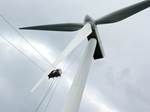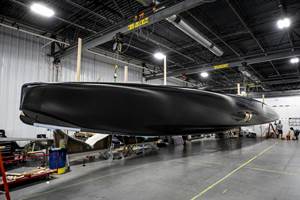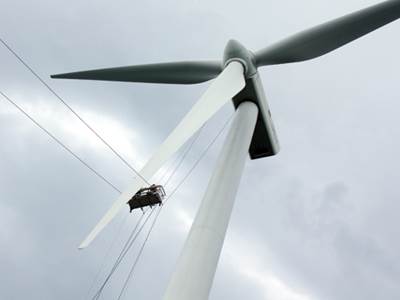Wind blade repair: Planning, safety, flexibility
Wind turbine blade maintenance and repair was an important and growing issue taken up by two speakers at ÂÌñÏ×ÆÞ’s 2011 Wind and Ocean Energy Seminar, held in April in Portland, Maine.
Somewhat lost in the buildup of the wind energy industry during the past few years is an important challenge that is getting more attention among wind farm managers and the composites industry: wind blade maintenance and repair. These structures are exposed constantly to mechanical and heat load cycles. Each is struck by lightning at least once in its lifetime, must withstand the force of wind and all the debris it brings with it and, thus, must be regularly maintained to remain functional.
Tackling maintenance and repair issues and their increasing complexity were two speakers at ÂÌñÏ×ÆÞ’s 2011 Wind and Ocean Energy Seminar, held in April in Portland, Maine. Malcolm Rosenow, a global new business development consultant based in Aiken, S.C., discussed repair challenges in the wake of blade warranty expirations. Juan Borges, a composites engineer at WindCom (Houston, Texas), presented a case history of offshore wind blade repair strategies.
Most notable about Rosenow’s presentation was the fact that most rotor blades carry post-installation warranties for one to two years. For structures with an expected service life of 15 to 20 years, this leaves much of the blade’s maintenance outside the warranty window. By the end of 2011, the warranties will expire on 25,000 turbines (75,000 blades). The warranties on another 28,000 turbines (84,000 blades) will expire by the end of 2012. In fact, as a result of the 2007-2009 wind energy boom, there are now more turbines with expiring warranties than are being installed. This is putting immense pressure on wind farm managers as they try to optimize turbine uptime.
Complicating matters, Rosenow notes, is the proprietary nature of resin, fiber and manufacturing systems used in wind blade manufacturing — varying ply patterns and core types, epoxy vs. vinyl ester, infusion vs. prepreg, etc. For repair specialists, who most often don’t have access to the original (legacy) material, the challenge is to find composite products (resins, fabrics, adhesives) that are equivalent to the legacy material in the blade. Further, the blade repair community is, for the most part, unregulated, which results in a variety of repair capabilities among specialists.
Blade repair is no trivial matter for wind farm managers. The sources of blade damage include mishandling during delivery and/or installation, lightning strikes, ice, thermal cycling, leading and trailing edge erosion, fatigue, moisture intrusion and foreign object impact (often bullets). An out-of-service turbine can cost $800 to $1,600 (USD) per day, with most repairs taking one to three days. If a crane is required to repair or replace a blade, the cost can run up to $350,000 per week. An average blade repair can cost up to $30,000. A new blade costs, on average, about $200,000.
Borges illustrated the challenges by presenting a case study regarding the repair of seven wind turbines off the east coast of Ireland. The turbines, which were installed in November 2003, have blades 50.5m/166 ft long. The repair project was scheduled for two months (May-June 2010). Offshore turbines pose significant logistical challenges, noted Borges, given their location in seawater and the fact that weather can be turbulent. The repair team had to decide how it would access each tower and determine the allowable loads for each, then build a platform from which to work on each tower. Onsite, the team had to account for tidal direction during tower approach, transfer the platform from the barge to the tower and monitor weather windows to maximize repair efficiency.
The repair firm used a metal platform that was hoisted by jack-up barge and placed on a fixed platform located at the base of each turbine tower. Crews then hoisted the mobile platform by rope up the tower to access and work on each blade.
Borges noted that most blade damage was from erosion and lightning strikes. In this case, all materials used to execute repairs were approved by the blade manufacturer. The repair procedures revolved around four primary functions: preparation of the damaged site, hand layup, postcure and leading-edge coating application. Most challenging was the repair of lightning damage. The damage at the blade’s surface typically showed only minor effects, but removal of the blade skin often revealed extensive internal damage that required replacement of relatively large blade sections. This included scarfing the old material, laying up the new laminate and applying a coating. Borges, in particular, thinks there is a market opportunity for an effective, long-lasting leading edge coating for wind blade applications.
Borges recapped the lessons learned from the case study: Detailed planning is required to cope with narrow weather windows. Efficient execution is necessary. Safety is paramount. Flexibility in the choice of tower access is mandatory.
Related Content
IPSA acquires bonding adhesives based on MMA technology
IPS Adhesives (IPSA) introduces a line of adhesives using acrylate and MMA technology from L&L Products for the bonding of dissimilar materials such as metals and composites.
Read MoreInnovations deliver improved composite bonding, sealing and structural reinforcement
JEC World 2025: L&L Products is exhibiting newly announced and proven technology solutions for composites fabricators, addressing core, adhesive and sealant needs.
Read MoreBiDebA project supports bio-based adhesives development for composites
Five European project partners are to engineer novel bio-based adhesives, derived from renewable resources, to facilitate composites debonding, circularity in transportation markets.
Read MorePro-Set named official materials supplier for New York Yacht Club American Magic
Competitive sailing team prepares for the 37th America’s Cup beginning in August 2024 with adhesives, resins and laminate testing services for its AC75 monohull construction.
Read MoreRead Next
Blade repair: Closing the maintenance gap
Citing difficult work conditions, lack of OEM guidance and underdeveloped inspection technologies, those who service wind turbine blades seek remedial solutions.
Read MoreCeramic matrix composites: Faster, cheaper, higher temperature
New players proliferate, increasing CMC materials and manufacturing capacity, novel processes and automation to meet demand for higher part volumes and performance.
Read MoreNext-gen fan blades: Hybrid twin RTM, printed sensors, laser shock disassembly
MORPHO project demonstrates blade with 20% faster RTM cure cycle, uses AI-based monitoring for improved maintenance/life cycle management and proves laser shock disassembly for recycling.
Read More








